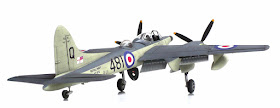From Wikipedia'
The Hornet was designed with the possibility of naval service on carriers firmly in mind. To this end good low-speed handling was required, along with good all-round visibility for the pilot. The basic Hornet design excelled at meeting these requirements. Shortly after the first Hornet prototype flew, Specification N.5/44 was issued to de Havilland, covering the modification of the Hornet for naval service. The Heston Aircraft Company was contracted to carry out the conversion work on three early production F.1s. The work entailed altering the wings to incorporate folding mechanisms so that each outer wing panel, from the aileron/flap line outboard could be folded upwards and inwards at an angle. The hinges were part of the upper wing skin structure while the lower wing skins incorporated securing latches, and Lockheed hydraulic jacks were used to move the wing panels. Slotted flaps were introduced to improve low speed "flaps down" control.
Sea Hornet NF.21 of the Airwork FRU displayed at RNAS Stretton in 1955. The radar thimble nose of this variant is evident
Merlin 133/134s (derated from 2,070 hp/1,543 kW to 2,030 hp/1,535 kW) were fitted to all Sea Hornets. Other specialised naval equipment (mainly different radio gear) was fitted and provision was made for three camera ports, one on each side of the rear fuselage and one pointing down. Sea Hornet F.20s also incorporated the modifications of the Hornet F.3, although the internal fuel capacity was 347 Imp gal (1,557 l), slightly reduced from that of the F.1. The modifications added some 550 lb (249 kg) to the weight of the aircraft. Maximum speed was decreased by 11 mph (18 km/h).[14]
The Hornet NF.21 was designed to fill a need for a naval night fighter. Special flame-dampening exhausts were installed, and a second basic cockpit was added to the rear fuselage, just above the wing trailing edges. ASH radar equipment was placed in the rear of this cockpit, with the radar operator/navigator seated facing aft. To gain access, a small trapdoor was provided in the lower fuselage; a fixed, teardrop-shaped bubble canopy, which could be jettisoned in an emergency, provided a good field of view. At the front of the aircraft, the nose underwent a transformation with the small rotating ASH radar dish being housed under an elongated "thimble" radome. The horizontal tail units were increased in span. The effect of these modifications on performance was minimal; about 4 mph (6 km/h).
The Sea Hornet PR.22 was a dedicated photo reconnaissance aircraft version of the F.20. The cannon were removed and the apertures faired over. Three cameras were installed in the rear fuselage: two F.52s for night use and one K.19B for day. A total of 23 PR.22s were built, interspersed with F.20s being built at Hatfield.
Captain Eric "Winkle" Brown, former fighter pilot and officer of the Fleet Air Arm, was one of the world's most accomplished test pilots and he still holds the record for flying the greatest number of aircraft types.
Just after VE Day the first semi-naval Sea Hornet PX 212 arrived at the RAE, Farnborough. Eric Brown initiated "work-up to deck-landing" trials. 37 years later, he was still impressed:
- "...the next two months of handling and deck landing assessment trials were to be an absolute joy; from the outset the Sea Hornet was a winner!"
- "The view from the cockpit, positioned right forward in the nose beneath a one-piece aft-sliding canopy was truly magnificent. The Sea Hornet was easy to taxi, with powerful brakes... the takeoff using 25 lb (2,053 mm Hg, 51" Hg) boost and flaps at one-third extension was remarkable! The 2,070 hp (1,540 kW) Merlin 130/131 engines fitted to the prototypes were to be derated to 18 lb (1,691 Hg, 37" Hg) boost and 2,030 hp (1,510 kW) as Merlin 133/134s in production Sea Hornets, but takeoff performance was to remain fantastic. Climb with 18 lb boost exceeded 4,000 ft/min (1,200 m/min)"...
- "In level flight the Sea Hornet's stability about all axes was just satisfactory, characteristic, of course, of a good day interceptor fighter. Its stalling characteristics were innocuous, with a fair amount of elevator buffeting and aileron twitching preceding the actual stall"...
- "For aerobatics the Sea Hornet was absolute bliss. The excess of power was such that manoeuvres in the vertical plane can only be described as rocket-like. Even with one propeller feathered the Hornet could loop with the best single-engine fighter, and its aerodynamic cleanliness was such that I delighted in its demonstration by diving with both engines at full bore and feathering both propellers before pulling up into a loop!"
- "Landings aboard Ocean had been made without any crash barrier... Yet, in the case of the Sea Hornet, I had felt such absolute confidence that I was mentally relaxed... Indeed, there was something about the Sea Hornet that made me feel that I had total mastery of it; I revelled in its sleek form and the immense surge of power always to hand..."
- "Circumstances had conspired against the Sea Hornet in obtaining the recognition that it justly deserved as a truly outstanding warplane...in my book the Sea Hornet ranks second to none for harmony of control, performance characteristics and, perhaps most important, in inspiring confidence in its pilot. For sheer exhilarating flying enjoyment, no aircraft has ever made a deeper impression on me than did this outstanding filly from the de Havilland stable."










No comments:
Post a Comment